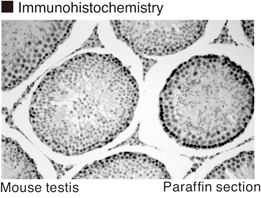This site is for customers in Asia.
Customers in China & other regions, please go to Global page.
HOME >
Product search results > Code No. MI-11-3
Anti-Bromodeoxyuridine mAb
Availability (in Japan)
10 or more
(In Japan at 00:05,
Apr 18, 2024 in JST)
Size
100 µL (1 mg/mL)
| Data | |||||
|---|---|---|---|---|---|
| Clonality | Monoclonal | Clone | 2B1 | ||
| Isotype (Immunized Animal) | Mouse IgG1 | ||||
| Applications |
|
||||
| Immunogen (Antigen) | 5-Iodouridine-Ovalbumin | ||||
| Reactivity [Gene ID] | Human |
||||
| Storage buffer | 1 mg/mL in PBS/50% glycerol, pH 7.2 | ||||
| Storage temp. | -20°C | Conjugate | Unlabeled | Manufacturer | MBL |
| Alternative names | BrdU, 5-Bromo-2-Deoxyuridine | ||||
| Background | BrdU (5-Bromo-2-Deoxyuridine) is a derivative of uridine that can substitute for thymidine during DNA synthesis. The detection of BrdU incorporation into DNA is a common method to quantify newly synthesized DNA and to identify cells in the S-phase of the cell cycle. BrdU incorporation is frequently used in proliferation assays to study DNA repair, sister chromatid exchange, and the cytokinetics of normal and neoplastic cells. | ||||
| Related products | MI-11-5 Anti-Bromodeoxyuridine mAb-PE M075-3 Mouse IgG1 (isotype control) PM077 Anti-5-hydroxymethylcytosine (5hmC) pAb D346-3 Anti-5-methylcytidine (m5C) mAb D347-3 Anti-Pseudouridine mAb M227-3 Anti-Digoxigenin (DIG) mAb D345-3 Anti-1-methyladenosine (m1A) mAb M218-3 Anti-5-hydroxymethylcytosine (5hmC) mAb M228-3 Anti-FITC mAb RN019M Anti-2,2,7-trimethylguanosine (m3G/TMG) mAb RN016M Anti-7-methylguanosine (m7G)-Cap mAb RN017M Anti-7-methylguanosine (m7G) mAb PM098 Anti-Inosine pAb |
||||
| Citations |
Immunoprecipitation
Flow Cytometry
Immunocytochemistry
Immunohistochemistry
Immunofluorescence
RNP Immunoprecipitation
Other
|
||||
| Product category |
|
||||
- The availability is based on the information in Japan at 00:05, Apr 18, 2024 in JST.
- The special price is shown in red color.
- Please note that products cannot be ordered from this website. To purchase the items listed in this website, please contact us or local distributers.
- Abbreviations for applications:
WB: Western Blotting, IH: Immunohistochemistry, IC: Immunocytochemistry, IP: Immunoprecipitation
FCM: Flow Cytometry, NT: Neutralization, IF: Immunofluorescence, RIP: RNP Immunoprecipitation
ChIP: Chromatin Immunoprecipitation, CoIP: Co-Immunoprecipitation - For applications and reactivity:
*: The use is reported in a research article (Not tested by MBL). Please check the data sheet for detailed information.
**: The use is reported from the licenser (Under evaluation or not tested by MBL).
- For storage temparature: RT: room temparature
- Please note that products in this website might be changed or discontinued without notification in advance for quality improvement.











 Citations
Citations Data Sheet
Data Sheet


